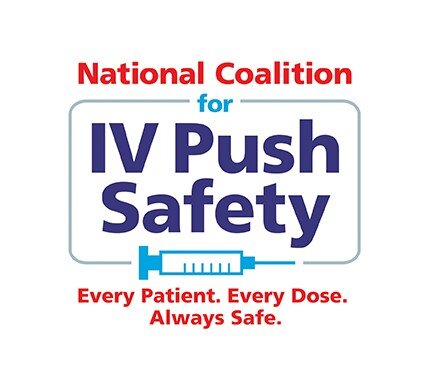+ Why is intravenous push (IVP) medication preparation and administration the focus of the coalition?
Patient safety is a priority when administering a medication. Consistent practices contribute to safety. Unfortunately, there is significant variation with IV push medication administration, including inappropriate dilution. We have made significant strides working with QSEN and publishers to align best practices.
+ I was always taught to dilute IV push medications, is this wrong?
Dilution of IVP medications is no longer indicated for most IV push medications. Only a few specific drugs require dilution and the pharmacy should provide the drug in a ready to use form or provide specific instructions for the nurse if dilution needed. As more drugs are purchased in ready-to-administer syringes, dilution adds an unnecessary step in the process.
+ My practice has always been to dilute IVP medications with a prefilled syringe of normal saline so that I can control the rate of administration more easily, what is wrong with that?
The majority of prefilled syringes of normal saline have been approved by the Federal Drug Administration (FDA) as flushing devices ONLY, not for the reconstitution or dilution of medications. If the medication is added to a flushing device, it would be considered a mislabeled medication, and pose a risk of inadvertent administration as a flush. Further, this practice is considered “off label” use of a medication and could have legal implications. If dilution of a medication is indicated, a vial of appropriate diluent should be used.
+ My drug reference guide states that I should dilute IVP medications such as morphine, are you saying the drug reference guides are incorrect?
A majority of nursing and pharmacy drug guides no longer recommend diluting morphine.
+ What is the problem with diluting opioids for IV Push administration?
There is no evidence to support the dilution of opioid medications. There are no manufacturer guidelines that require dilution of opioids. There are no evidence-based publications to support this practice.
+ If I don’t dilute, how do I control the rate of administration of a small volume of medication?
Most IV push medications are injected via extension tubing or into a running IV line. Consider the fill volume of the tubing between the patient and the syringe. Inject the medication into the line, flush with a prefilled saline syringe after injecting the medication. Control the rate of the drug by using the same rate of administration for the flush used to clear the tubing.
+ What medications need to be diluted for IV push administration?
The following medications require dilution: ranitidine, famotidine, pantoprazole, lorazepam, promethazine. In certain settings, the following drugs require dilution in order to give them IV push: Digoxin Immune FAB, ephedrine, phentolamine, phenylephrine, phenytoin, vitamin K, magnesium sulfate.
+ I was taught that I must use a 10ml syringe to inject medications into a central line or PICC line, is that incorrect?
That is partially correct. Use a 10 mL diameter syringe to assess patency of a central venous access device. Once patency is confirmed, used a syringe appropriately sized for the medication being injected. Infusion Nurse Society Standard #40, Practice Criteria (D)(3).
+ What is the problem with manipulating drugs for IV Push administration?
Prefilled medication syringes and cartridges are provided in an approved concentration and are sterile products. Transferring the drug to a new syringe, and/or diluting increases the risk of contamination or a medication/dosing error. The prefilled syringes or cartridges are bar-coded to facilitate the 5 Rights of Medication Safety. Drugs that are provided in vials should be drawn up into the appropriate size syringe and only diluted if required.
+ I like to dilute my IVP medications to decrease patient discomfort when I inject them, is this OK?
The most important strategy nurses can use to avoid pain and complications is to ensure that the IV is patent with a good blood return. Pain on injection is often related to a failing site. The nurse should ensure that the line is patent with good blood return, without swelling or signs of phlebitis (red or warm). A catheter that is the improper IV size for the vessel, may also be a contributor. The patient may perceive the temperature difference between a room temperature IV medication and their own body temperature as discomfort.
+ What about using a prefilled cartridge as a multi-dose “vial”?
Prefilled cartridges were introduced to save time and reduce the potential for medication errors by limiting the number of steps required for preparation of an injectable medication. Over the years, nurses have adopted an unsafe practice of using the prefilled syringe cartridges as single-dose or multiple-dose vials by withdrawing the medication from the cartridges. Using the cartridges as vials can lead to contamination when transferring the drug to a new syringe. This unsafe practice also can lead to dosing errors, drug mix-ups, and other types of medication errors, particularly because the prepared syringes are often unlabeled.
+ How long can I keep an IV push medication that I have prepared at the bedside?
An IV push medication prepared at the bedside is intended for immediate use and should be discarded if not used within 1 hour (USP 797, 2008).
+ Can I mix more than 1 medication in a syringe for IV push administration?
Yes…but. Syringes prepared for immediate use should not involve the use of more than 3 compatible products (including any diluent) and not more than two entries into any one container or package (e.g., bag, vial) of sterile infusion solution or administration container/device (USP 797, 2008).

